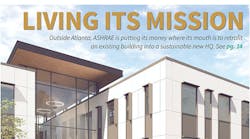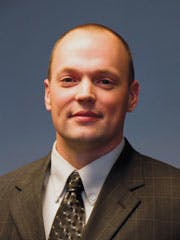While assisting with the commissioning of a biosafety level 3 laboratory for agricultural hazards, I was asked by the project manager to investigate why the two 100-percent-redundant, HEPA-filtered, high-velocity exhaust fans serving the space were not performing as designed. Troubleshooting the system led to a substantial learning experience.
Normal operating mode had the two fans operating in parallel. In the event of a fan failure, the remaining fan would ramp up to maintain the field-adjustable (FA) exhaust static-pressure setpoint of −2.95 in. wc. To ensure critical room-pressure differentials in the space were maintained, this pressure setpoint was achieved with both fans running at 48.6 Hz variable-frequency-drive (VFD) speed. During an initial fan-failure test, with one fan stopped and its associated isolation dampers closed, the remaining fan ramped up to 60 Hz, but could achieve static pressure of only −1.45 in. wc.
During the transition from two redundant to one single operating fan, critical room differential pressure was being lost. Although some of the pressure-independent, constant-volume boxes achieved design flow in the space and began throttling, several did not and were 100-percent open. In the time between a single fan failing and closing its isolation damper and the redundant fan ramping up to meet load, the air terminals opened up, looking for more flow. The boxes on the shortest (lowest pressure drop) branches were able to achieve flow and begin throttling, but the boxes on more distant (higher pressure drop) branches were starved—and the static-pressure setpoint was never reached on one fan.
As I traversed the “clean” side of the ductwork up to the HEPA-filter caisson to create a static-pressure profile of the system, I looked for significant losses that could be corrected. I did not continue the profile on the “dirty” side of the HEPA filters, as this would call for drilling into fully welded stainless-steel ductwork.
The HEPA caisson had three distinct filter banks with decontamination ports and bubble-tight dampers upstream and downstream of each filter to allow for decontamination in place prior to filter removal. Through a systematic series of measurements, I determined one of the bubble-tight HEPA-filter isolation dampers was closed. The indicator on the manual operator was installed incorrectly, showing “open” when the damper was closed. This effectively closed off one-third of the HEPA-filter free area and added significant pressure drop across the remaining filters. By increasing the flow to 150 percent of design on the remaining filters, the pressure drop more than doubled.
With the indicator fixed and HEPA-filter-bank isolation damper open, the failure-mode test was repeated. A single installed fan running alone still could not maintain static-pressure setpoint in the space, but it did show improvement, and we were able to hold −1.80 in. wc, while all air terminals began to throttle, the worst of which was 95-percent open. Critical room airflows and differential pressures were maintained to guarantee containment in the space. Job done, right?
Wrong. Now we had a system that was just barely functioning with clean HEPA filters while maintaining an exhaust-fan static setpoint of −2.95 in. wc. How were we going to ensure the system was robust enough after including the additional 1.0-in.-wc pressure drop with dirty filters? Where could we find an additional 1 in. wc of pressure from this system to make the current installation work without significant change orders or schedule delays?
While studying the building-automation system, I noticed while maintaining −2.95-in.-wc setpoint at the exhaust main, the worst-case terminal box was controlling to only 40-percent open, and all others serving the space were less open. Because they were pressure-independent, constant-flow boxes, I began to manipulate the static setpoint. Simultaneously watching all the boxes serving the space as I very slowly lowered the setpoint, I watched until at least one box was 75-percent open to ensure the air terminals were still in a controllable range. This allowed for my new static-pressure setpoint to be −2.0 in. wc. I found enough additional static to compensate for the dirty filters, with little more cost invested than a couple hours of time.
In my quest for the system to achieve the static-pressure setpoint and provide stable flow for the exhaust system while operating one fan, I contacted the fan, motor, and VFD manufacturers. Getting all of their blessings, I increased the 100-percent VFD maximum speed to 66 Hz. This allowed for the same exhaust static setpoint of −2.0 in. wc to be reached, regardless of whether one or two fans were operating.
Analyze the System, Not the Components
The most important lesson learned from this troubleshooting exercise is that, many times, the engineer of record will enter a conservative static- pressure setpoint based on the engineering calculation of the system design (−2.95 in. wc FA in this case). The FA option rarely is exercised on a system that functions per design intent. I never would have thought twice about it if this system passed the fan-failure-mode functional-performance test.
As commissioning agents, we work closely with test-and-balance and controls contractors, ensuring a fully functioning building system is delivered to the client. We are ethical professionals, and our clients deserve the attention required to fine-tune their systems vs. us simply “kicking the tires.”
According to the fan laws:
√(2.00 in. ÷ 2.95 in.) × 48.6 Hz = 40 Hz
which is the new exhaust-fan speed to maintain set point.
(40 Hz ÷ 48.6 Hz)³ = 55.8 percent
which is the reduction in power consumption required to maintain the new lower setpoint.
We started at a reasonable 10-hp operating point; we are now operating at 5.6 hp. That is a 4.4-hp savings, or 3.3 kw, which is nearly 28,900
kwh per year.
Based on the local electrical rates, this subtle and unnoticed setpoint manipulation from −2.95 in. to −2.00 in. saved this client more than $2,500 per year in electrical utility costs on a system that runs 24/7 because the fans no longer must maintain an arbitrarily high static setpoint.
This was one air system in a building with five air handlers and eight exhaust fans, with hot-water and chilled-water pumps and piping. I estimate an additional $10,000 per year could be saved if the same investigation was completed on all systems. That may not be significant to a building that consumes $25,000 per month in electricity, but it is real dollars and real savings in resource consumption and carbon-dioxide production. The payback period for this exercise was only a couple of months and has a return on investment that will carry forward.
Take a close look at balancing valves and dampers, circuit setters, and control valves and dampers as a whole system, and look for inefficiencies. Are you maintaining artificially high setpoints on the HVAC project you are working on right now? Are you operating with the least amount of acceptable pressure drop across the fans and pumps? Are there artificial inefficiencies that could be removed with little effort to make the system perform better, more efficiently, and more cost-effectively than it does today?








